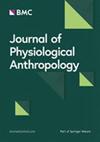Effects of exercise habituation and aging on the intersegmental coordination of lower limbs during walking with sinusoidal speed change
IF 2.1
4区 医学
Q1 Social Sciences
引用次数: 2
Abstract
The time courses of the joint elevation angles of the thigh, shank, and foot in one stride during walking can be well approximated by a “plane” in a triaxial space. This intersegmental coordination (IC) of the lower limb elevation angles is referred to as the planar covariation law. We examined the effects of exercise habituation and aging on the thickness of the IC plane of the lower limbs under sinusoidal speed changing conditions. Seventeen sedentary young (SY), 16 active young (AY), and 16 active elderly (AE) adults walked on a treadmill in accordance with a sinusoidal speed changing protocol at 120, 60, and 30 s periods with an amplitude of ± 0.56 m·s−1. Motion of the lower limbs from the sagittal direction was recorded to calculate the elevation angles of the lower limbs. When the best-fit IC plane was determined, the smallest standard deviation of the IC plane was considered as the anteroposterior gait variability of the lower limbs. The coefficient of variance of the step width was also quantified to evaluate the lateral step variability (CVSW). The standard deviation of the IC plane was significantly greater in the order of SY, AY, and AE, regardless of the sinusoidal wave periods of the changing speed. The CVSW was not significantly different among the three groups. Exercise habituation influences anteroposterior gait variability of the lower limbs, but not lateral step variability, even in young adults. Given these, gait adaptability for sinusoidal speed changes does not always decline with aging. UMIN000031456 ( R000035911 ; registered February 23, 2018).运动习惯和衰老对正弦速度变化步行时下肢节间协调的影响
行走时,大腿、小腿和足的关节仰角在一个跨步中的时间轨迹可以很好地近似于三轴空间中的“平面”。这种下肢仰角的节段间协调被称为平面共变规律。我们研究了运动习惯和衰老对正弦变速条件下下肢IC面厚度的影响。17名久坐不动的年轻人(SY)、16名活跃的年轻人(AY)和16名活跃的老年人(AE)在跑步机上按照正弦波速度变化方案在120、60和30秒的周期上行走,幅度为±0.56 m·s−1。记录下肢矢状方向的运动,计算下肢仰角。当确定最适合的IC平面时,将IC平面的最小标准差作为下肢的前后位步态变异性。台阶宽度的方差系数也被量化,以评估横向台阶变异性(CVSW)。无论速度变化的正弦波周期如何,IC平面的标准差在SY、AY、AE的顺序上都明显较大。三组间CVSW无显著差异。运动习惯影响下肢的前后步态变异性,但不影响侧向步变异性,即使在年轻人中也是如此。考虑到这些,步态对正弦速度变化的适应性并不总是随着年龄的增长而下降。Umin000031456 (r000035911;2018年2月23日注册)。
本文章由计算机程序翻译,如有差异,请以英文原文为准。
求助全文
约1分钟内获得全文
求助全文
来源期刊

Journal of Physiological Anthropology
Social Sciences-Human Factors and Ergonomics
CiteScore
4.80
自引率
6.50%
发文量
39
审稿时长
>12 weeks
期刊介绍:
Journal of Physiological Anthropology (JPA) is an open access, peer-reviewed journal that publishes research on the physiological functions of modern mankind, with an emphasis on the physical and bio-cultural effects on human adaptability to the current environment.
The objective of JPA is to evaluate physiological adaptations to modern living environments, and to publish research from different scientific fields concerned with environmental impact on human life.
Topic areas include, but are not limited to:
environmental physiology
bio-cultural environment
living environment
epigenetic adaptation
development and growth
age and sex differences
nutrition and morphology
physical fitness and health
Journal of Physiological Anthropology is the official journal of the Japan Society of Physiological Anthropology.
 求助内容:
求助内容: 应助结果提醒方式:
应助结果提醒方式:


